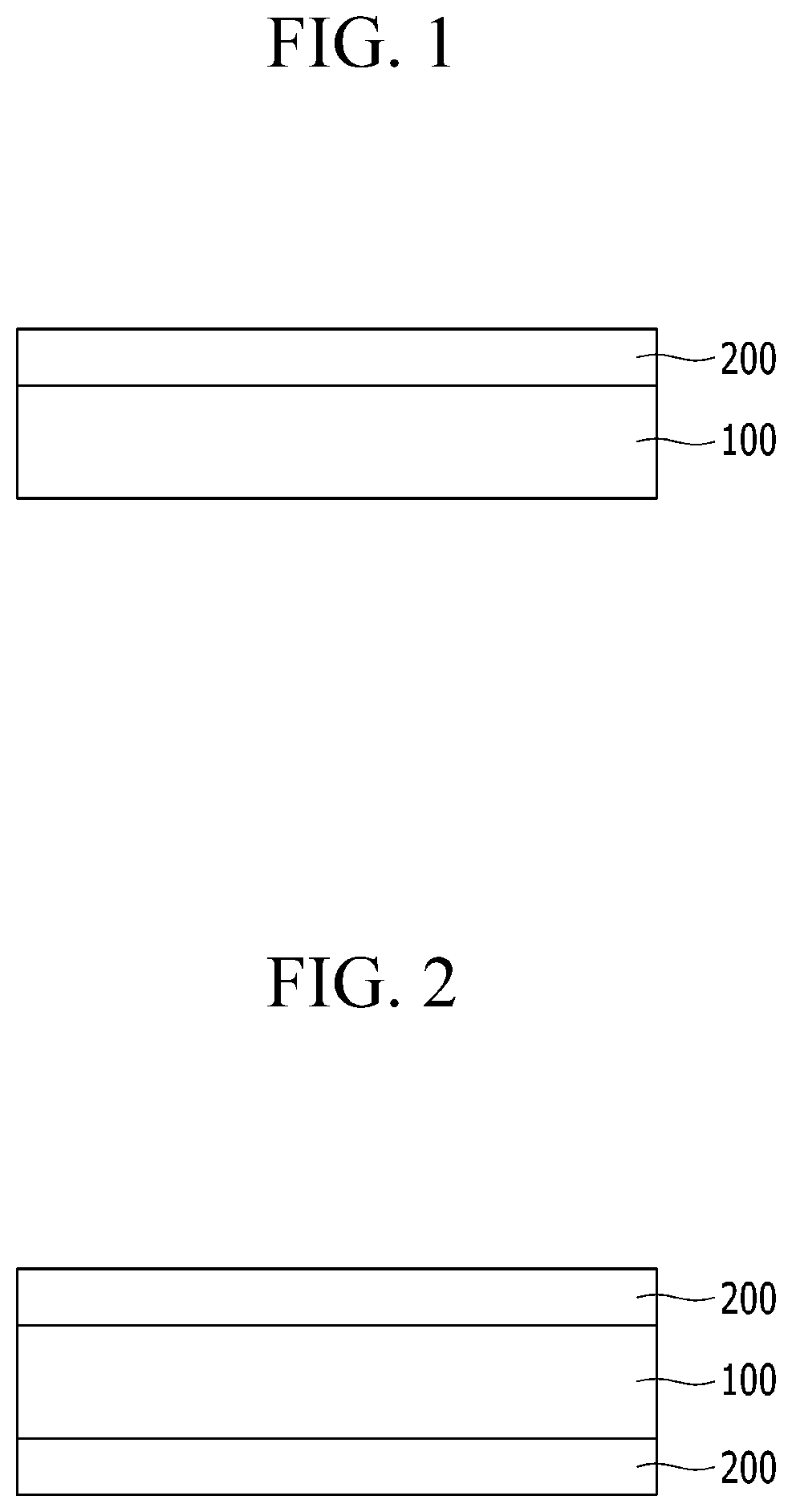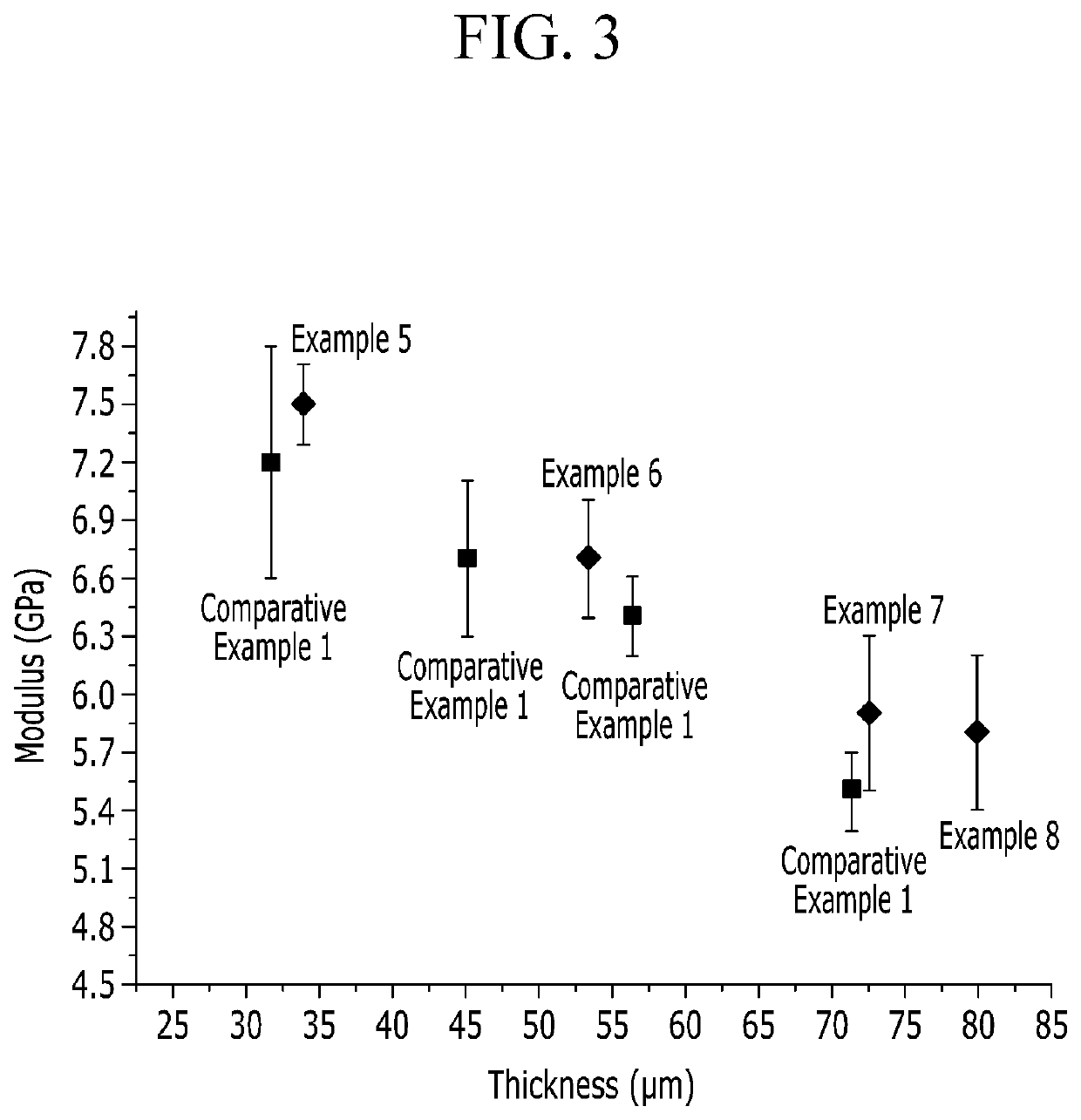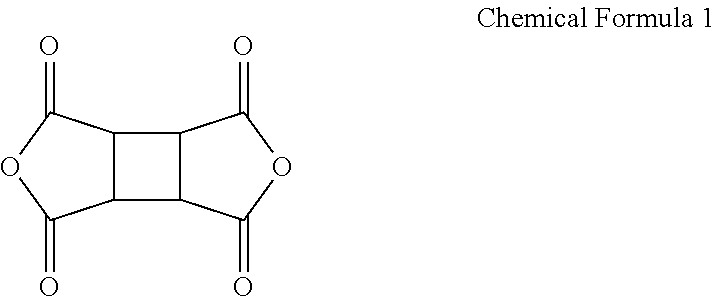Poly(amide-imide) copolymer film, window for display device, and display device
a copolymer film and film window technology, applied in the direction of identification means, instruments, other domestic objects, etc., can solve the problems of not being applied in a flexible display device, easy to crack or break, and difficult to satisfy good mechanical properties (such as hardness) and optical properties of the plastic film. achieve good mechanical and optical properties
- Summary
- Abstract
- Description
- Claims
- Application Information
AI Technical Summary
Benefits of technology
Problems solved by technology
Method used
Image
Examples
synthesis example 1
e Group-Containing Oligomer
[0093]An amide group-containing oligomer prepared from TPCI (terephthaloic dichloride) and TFDB (2,2′-bis(trifluoromethyl)benzidine) is prepared, wherein at both terminal ends of TPCI (terephthaloic dichloride) TFDB are bonded to form an aramid structure, according to the following Reaction Scheme 1:
[0094]
[0095]Particularly, 1 mole equivalent (0.107 moles (mol), 34.3 grams, g) of 2,2′-bis(trifluoromethyl)benzidine (TFDB) and 2.0 mole equivalents (0.3 mol, 23.7 g) of pyridine are dissolved in 700 g of N,N-dimethyl acetamide, as a solvent, in a round-bottomed flask, and the remaining TFDB is completely dissolved with further 50 milliliters (mL) of DMAC. Then, 15.2 g (0.7 mole equivalents, 0.075 mol) of TPCI (terephthaloic dichloride) is divided into four portions and mixed with the TFDB solution at 25° C., and the mixture is vigorously stirred for 15 minutes.
[0096]The resulting solution is stirred under nitrogen atmosphere for 2 hours, added to 7 liters (L) ...
example 1
on of Poly(Amide-Imide) Copolymer Film
[0097]170 grams of N,N-dimethyl acetamide (DMAc), as a solvent, is charged into a 250 mL reactor, pre-heated to 25° C. and equipped with a mechanical stirrer, a nitrogen inlet, and a cooler, while introducing nitrogen gas thereinto. Subsequently, 22.26 grams (0.0155 moles) of the amide group-containing oligomer prepared in Synthesis Example 1 and 1.27 grams (0.0039 moles) of TFDB are added thereto and dissolved. Then, 1.09 grams (0.0055 moles) of CBDA, 1.64 grams (0.0055 moles) of s-BPDA, and 3.72 grams (0.0083 moles) of 2,2-bis-(3,4-dicarboxyphenyl)hexafluoropropane dianhydride) (6FDA) are added to the solution, and the mixture is stirred for 48 hours at 25° C. Then, 4.64 grams of pyridine and 5.99 grams of acetic anhydride are added thereto, and the mixture is stirred for 24 hours to obtain a poly(amic acid-amide) copolymer solution, of which the solid content is 15 percent by weight (weight %).
[0098]After lowering the temperature of the poly(...
example 2
on of Poly(Amide-Imide) Copolymer Film
[0099]170 grams of N,N-dimethyl acetamide (DMAc), as a solvent, is charged into a 250 mL reactor, pre-heated to 25° C. and equipped with a mechanical stirrer, a nitrogen inlet, and a cooler, while introducing nitrogen gas thereinto. Subsequently, 10.03 grams (0.007 moles) of the amide group-containing oligomer prepared in Synthesis Example 1 and 9.94 grams (0.0031 moles) of TFDB are added thereto and dissolved. Then, 4.8 grams (0.024 moles) of CBDA, 1.6 grams (0.0054 moles) of s-BPDA, and 3.61 grams (0.0081 moles) of 6FDA are added to the solution, and the mixture is stirred for 48 hours at 25° C. Then, 9.03 grams of pyridine and 11.66 grams of acetic anhydride are added thereto, and the mixture is stirred for 24 hours to obtain a poly(amic acid-amide) copolymer solution, of which the solid content is 15 weight %.
[0100]After lowering the temperature of the poly(amic acid-amide) solution to 25° C., the solution is casted on a glass substrate, and...
PUM
| Property | Measurement | Unit |
|---|---|---|
| yellowness index | aaaaa | aaaaa |
| wavelength range | aaaaa | aaaaa |
| light transmittance | aaaaa | aaaaa |
Abstract
Description
Claims
Application Information
 Login to View More
Login to View More - R&D
- Intellectual Property
- Life Sciences
- Materials
- Tech Scout
- Unparalleled Data Quality
- Higher Quality Content
- 60% Fewer Hallucinations
Browse by: Latest US Patents, China's latest patents, Technical Efficacy Thesaurus, Application Domain, Technology Topic, Popular Technical Reports.
© 2025 PatSnap. All rights reserved.Legal|Privacy policy|Modern Slavery Act Transparency Statement|Sitemap|About US| Contact US: help@patsnap.com



